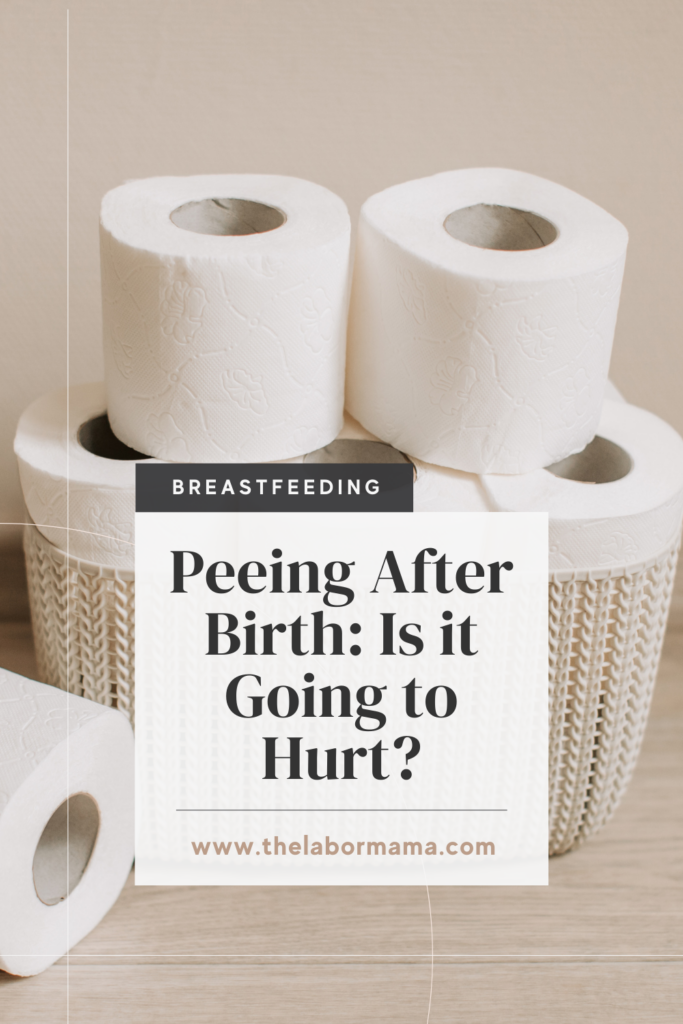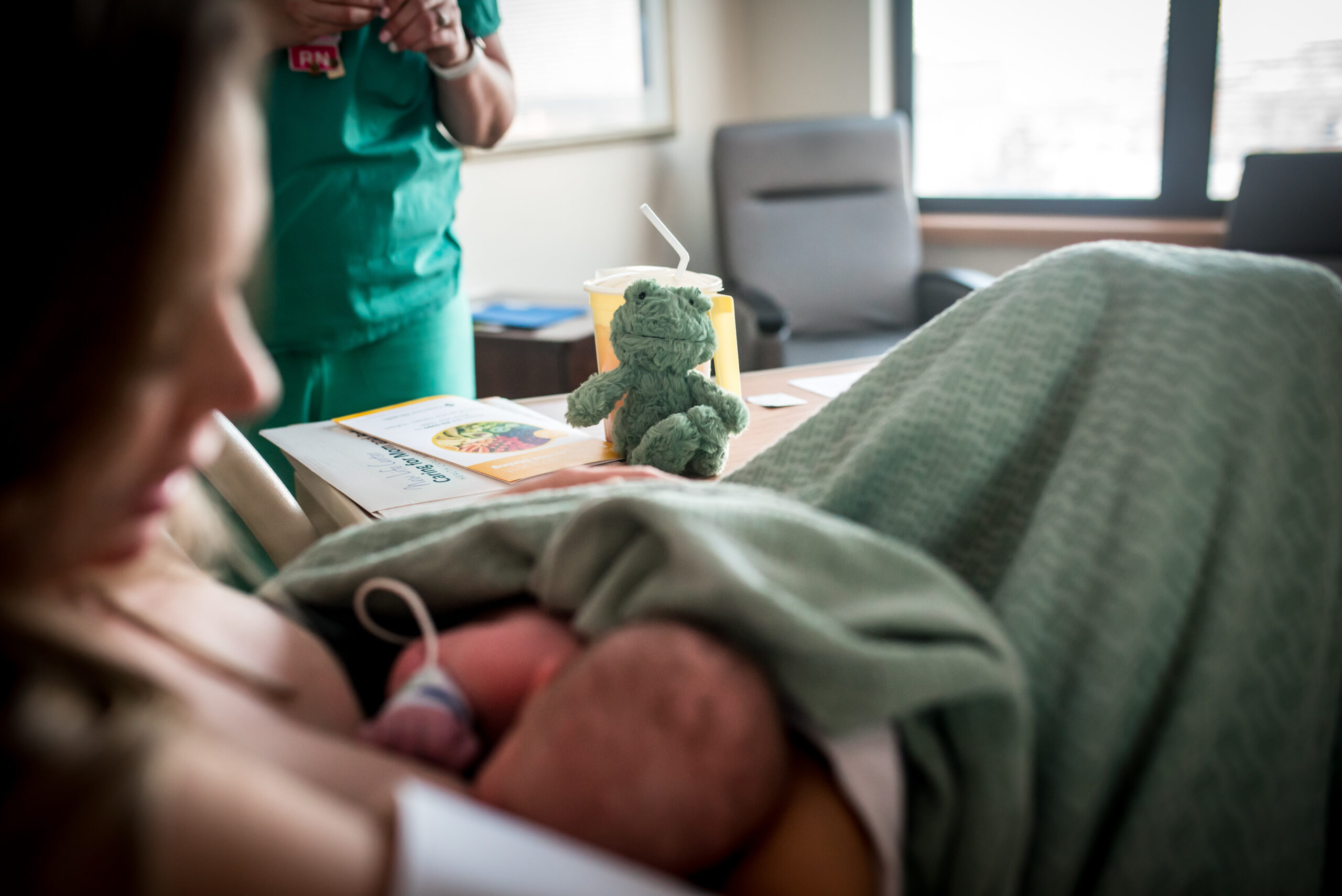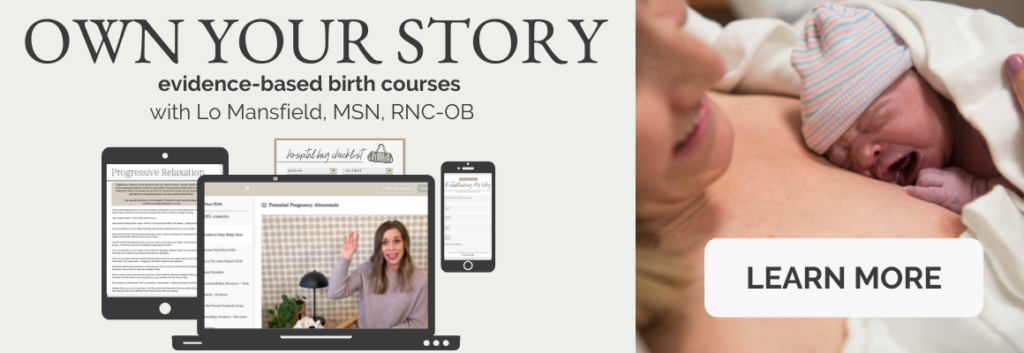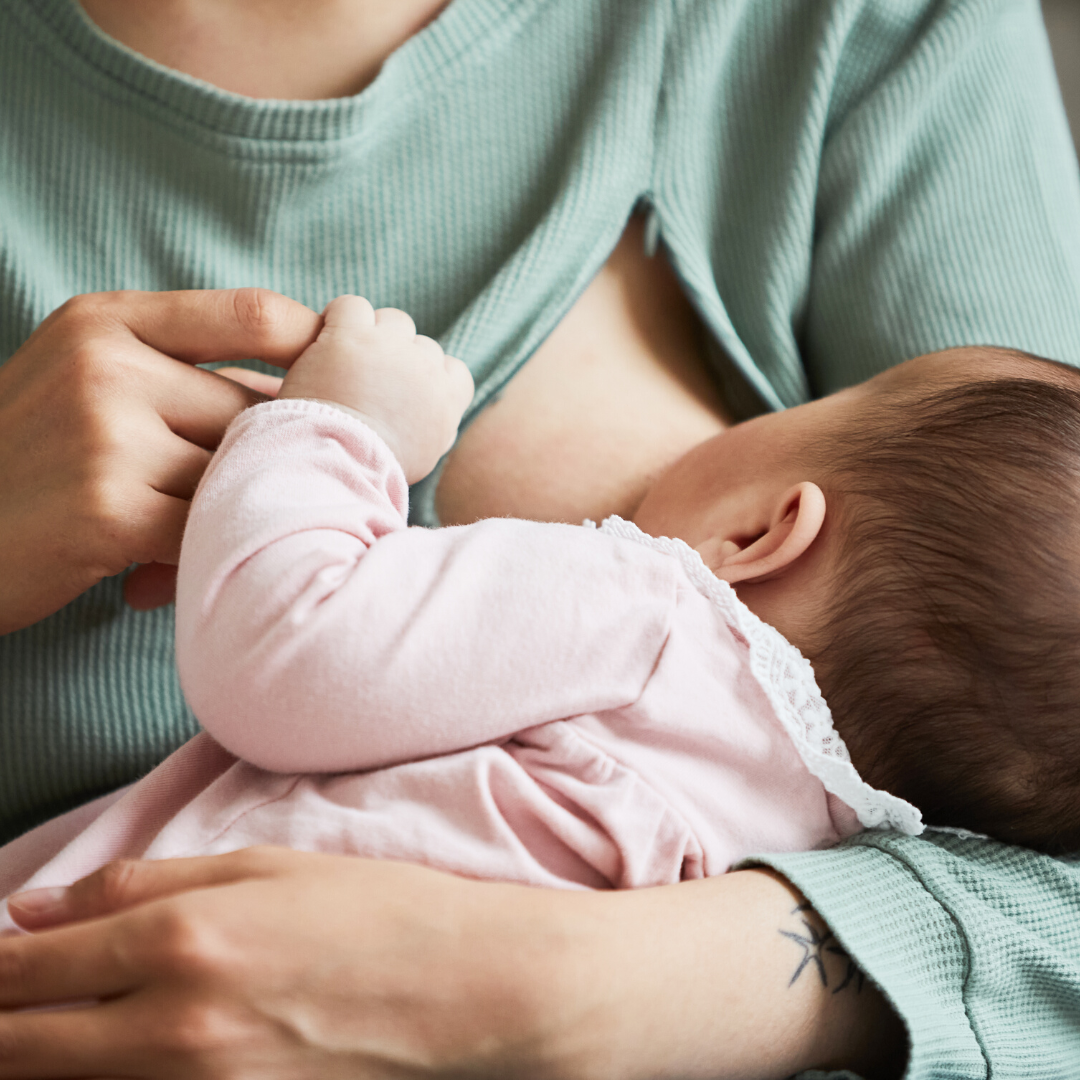Have you heard any horror stories about the first time peeing after birth? I bet you have. Or maybe you’ve heard that you can’t pee after a c-section? To be honest? This first pee after birth (and some of the ones that follow) can be a little bit tough or cause some challenges. This is true for those who have their baby vaginally and those who have their baby via cesarean birth. Interestingly, for as common as this situation is, there isn’t a ton of information on how to make it a bit easier. So, let’s do that here.
I’m going to walk through what urinary retention is, what causes it, what makes peeing after birth so (possibly) tough, and then I’ll share a couple things that may help you get that pee out so can get back in that bed snuggling your new baby.
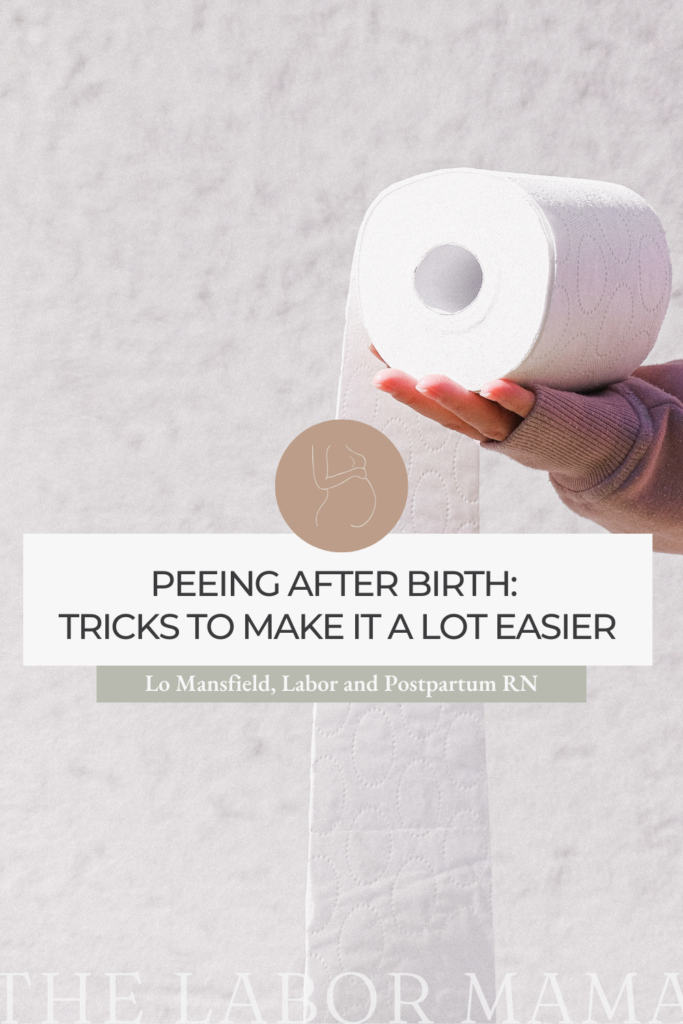
Who is The Labor Mama and Why Am I Here?
Hey friend! I’m Lo – also known around here and social media as The Labor Mama. I’ve spent my nursing career in labor, delivery, and postpartum, have birthed 3 of my own babies, have labored thousands of mamas at the bedside, have taught hundreds of students online, and have even delivered a few speedy little babies with my bare hands (oops).
Here at TLM, I offer online birth classes to empower you the way everyone should be. The education + support I offer gives you experience, evidence, and empathy; you’re getting all of my years of “clinical” RN knowledge, beautifully combined with my real experiences as a mama and a nurse. These are not your hospital birth classes (those won’t do it, I promise), and honestly, birth doesn’t follow a textbook or protocol anyway – you need to know so much more than that.
If you want to connect with me further, head to Instagram. There are hundreds of thousands of us over there learning together daily.
What is urinary retention after birth?
Postpartum urinary retention (PPUR) after birth is the clinical way of saying that you can’t pee after birth. Basically, what it means is that the bladder is having an issue fully emptying. It is a common issue (about 10% of vaginal deliveries) in the first 1-2 days post delivery. When the bladder doesn’t fully empty, the urine that is left behind is “retained.” The bladder then slowly fills back up and occasionally (read rarely), that over-stretching of the bladder could cause irreversible muscle or nerve damage or lead to the permanent need for a catheter to go pee.
There are some technical definitions of when a diagnosis of PPUR may be made. You may have PPUR if:
- You cannot spontaneously pee within 6 hours post delivery (or after urinary catheter removal)
- If there is > 150 ml (or cc) of urine left in your bladder after you go pee (150 mls is about 1/2 a can of soda pop)
What causes postpartum urinary retention?
There are a few different things which may lead to urinary retention after birth. Let’s walk through each of them briefly.
Pregnancy hormones
One big culprit is pregnancy hormones. Progesterone, which increases during pregnancy, actually decreases the muscle tone of the bladder. This is important, because during pregnancy, the bladder does need to get out of the way of the growing baby – and also not tell you that you need to pee all of the time. After birth, that decreased urge to go pee will eventually go away, but it takes some time for hormone levels to normalize.
Postpartum edema
Another common cause of PPUR is postpartum edema. That is a fancy way of saying postpartum swelling. While we commonly hear about swelling in the legs or the feet, your perineum, urethra, and tissues of the vagina can all swell as well after the physical trauma of birth.
Narcotic medication use during labor + birth
Today, many births, both vaginal and cesarean, utilize some form of narcotic pain medications for pain relief. This includes tools like an epidural or a spinal, as well as some IV medications that may be used. These medications can make the bladder processes a bit “sleepy” – but any of these effects should wear off quickly.
Maternal anxiety or fear
A lot of times, the patient is just scared to go! As we’ve discussed, it is normal for the first few pees after birth to be painful. Many have a mental block as they sit on the toilet and try to relax enough to let the pee flow.
What makes peeing after birth so important?
I have mentioned that overstretching of the bladder does have some potential longterm consequences on bladder function. But, it is rare that PPUR gets to that place. Most care providers will notice that something is going on and intervene before any significant bladder damage can occur. Curious how they will know there is a problem? Your uterus and your postpartum bleeding will tell them! And this is why urinary retention after birth is so important.
During postpartum care, it is very normal to get something called a fundal massage. A fundal massage is when a care provider places a hand on the outside of your body, near the top of your uterus, and rubs down firmly. If you’ve experienced these, you know that massage is really not the right word for it, right? During these fundal massages, the provider is checking for:
- The tone of the uterus (how firm it feels)
- The position of the uterus (it should be midline in the body and around the level of the belly button)
- The flow of blood from vagina
The uterus has the massively important job of contracting down after birth and stopping the bleeding that is occurring. Those postpartum cramps you feel? Those are your uterus doing its job! When the bladder is too full, it can actually push the uterus off to the side and “mess up” its job. This means that you can bleed more, which is definitely something we want to avoid post delivery! Basically, if the bladder doesn’t do its job (and stay empty), the uterus might not be able to do its job. And we’re not okay with that.
So, is peeing after birth really that hard?
Ok, I think you understand how important an empty bladder after birth is. So is peeing after birth really that hard? Honestly, for most of my patients, it’s only that very first pee (or maybe two) that causes a lot of issues. And most often, there is no reason they cannot pee – they’re just scared to go because they don’t want it to hurt!
What makes it hurt?
Most often, the pain associated with peeing after birth is related to any postpartum swelling “down there” and to any tears or episiotomies that were experienced during birth. Sometimes, the muscles in the vagina also get bruised during delivery, and that can make this all pretty uncomfortable too. Though I don’t want to say so, you probably should expect some burning and stinging – so here’s some tips to get past it.

Tricks for going pee after baby is born
Alright, it’s time for the tricks. Is going pee after birth going to hurt? Maybe. But do we need to get that pee out? Yes! Here are a few things I do with my patients to give them the best chance at a decent experience.
- Use a peribottle. The hospital provides one, but may mamas like bringing in their own too. Frida Mom makes this great one (pictured above) with a bent neck for best “aim” at the right areas. Fill it with semi warmish water and spray while the urine is coming out to reduce burning.
- Turn the tap on and let the water run. I know, this isn’t anything exciting. But running water can help your body relax and go!
- Put a couple of drops of peppermint oil in the toilet bowl. Essential oils for the win!
- Blow through a straw while you are sitting on the toilet. Just ask the RN for one or blow into your water bottle.
- Ask for privacy. This one feels silly, but it’s okay to say “hey, leave, I need a minute.” A lot of my patients just need a few moments alone to calm down, relax, and not be watched. If you feel fine, your RN can leave you alone in there.
- Get in the shower. If your legs are ready, getting in the shower (there’s usually a bench to sit on) helps calm you. The warm water can also help with any burning.
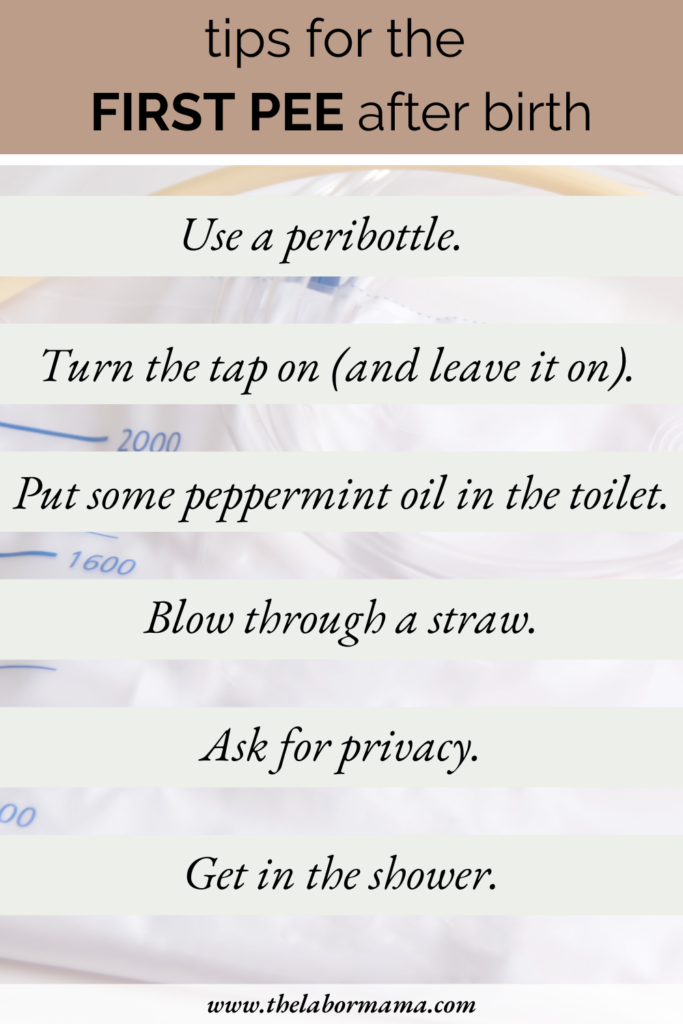
What if I can’t pee after birth?
Of course, every once in awhile none of the tricks work. Depending on your uterus and your bleeding, your RN may be able to give you a bit more time before trying again. The team can also do something called a bladder scan. This is a quick, painless bedside ultrasound to see how much urine is being left behind. When the bladder is too full and you just cannot pee on your own, a care provider may need to insert a straight catheter. This is also called an in and out catheter, because it goes in, empties the bladder fully, and then comes right back out.
The takeaway on peeing after birth
Peeing after birth can be a painful. It’d be dishonest to not admit that possibility! And I hope you’re one of the lucky ones who thinks the whole situation isn’t too bad! But just in case, I hope you now understand why those bladder problems happen, why it matters (no extra bleeding, mama!), and what tricks may help you get all of that pee out so you can get yourself off of that toilet and back to that baby.
